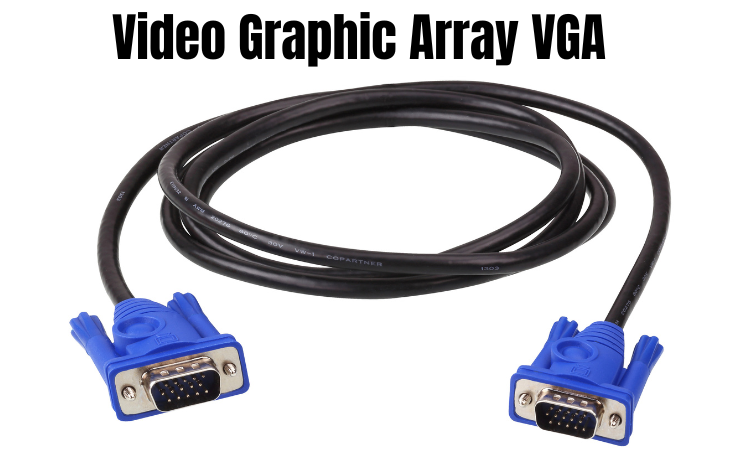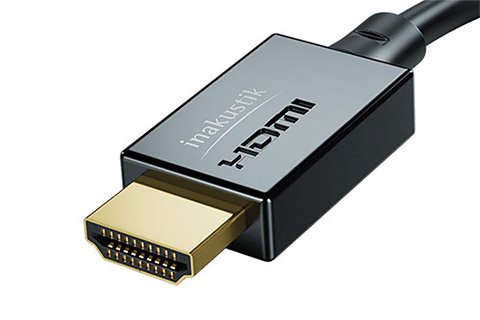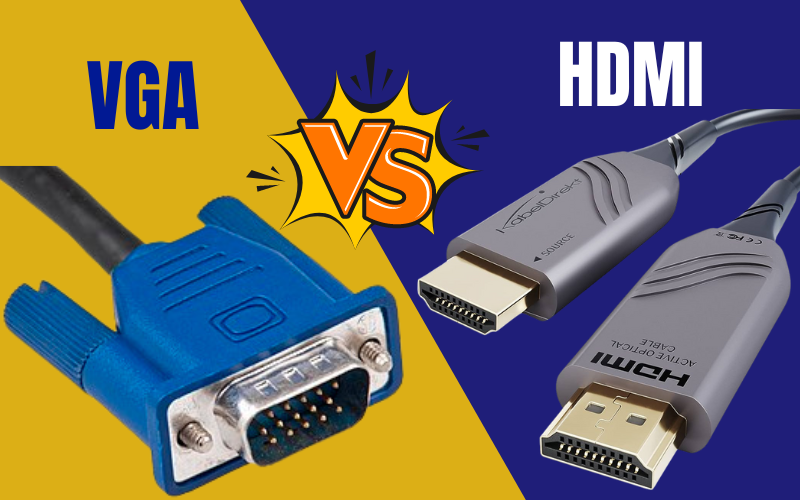Last Updated on 6 months by On Trends Gear
Better video interfaces and display controllers are becoming increasingly necessary with the introduction of outstanding display devices.
The outdated and relatively poor signal-quality VGA interface is in danger of going extinct because of this increased need for display quality.
Now, the better HDMI interface has mostly taken its place.
However, the VGA is still used in some gadgets and display equipment. It remains relevant in some domains as well.
So, what specific differences exist between the VGA vs HDMI interfaces? And which one ought you to select?
Let us find out in this article.
Table of Contents
What is VGA?

The acronym for Video Graphic Array is VGA.
At first, it covered display hardware made by IBM and used in the IBM PS/2 series of personal computers, which was introduced in 1987.
The technology gained so much traction that the 15-pin 3-row VGA connection, the 640×480 screen resolution of the VGA monitors, and an analog computer display standard were all referred to as VGA.
Various manufacturers have continuously upgraded VGA, improving signal quality and maximum display resolution support.
What is HDMI?

After being created in 2002, the High Definition Multimedia Interface (HDMI) quickly replaced previous computing standards.
High-definition (HD) video with resolutions of 1,920 x 1,200 pixels and eight audio channels can be concurrently provided using the HDMI standard, which enables the transfer of digital video and audio information via the same interface (port) and cable.
These days, only some gadgets support VGA. Most TVs and PCs only have HDMI ports; VGA ports are absent.
HDMI cables are provided for devices like Apple TV, Blu-Ray players, gaming consoles, and other comparable electronic gadgets since they offer digital copy protection of all signals.
VGA to HDMI Similarities
Here are some similarities between VGA and HDMI:
- Interface: Both VGA and HDMI serve as interfaces for transmitting video signals.
- Pins: Both VGA and HDMI include pins in their design.
- Compatibility through Converters: VGA and HDMI can be made compatible using converters. For instance, VGA signals can be converted to HDMI and vice versa.
VGA to HDMI Differences

Signal Quality
Crosstalk, signal interference from other cables, and length problems affect VGA cables;
The analog video signal tends to break down at distances greater than 4 feet.
Although HDMI connections are less susceptible to crosstalk, electromagnetic fields can still cause interference.
Thick insulation is a feature of the best HDMI cables, which helps to prevent this problem in spaces with several wires.
Nonetheless, most ordinary HDMI cables provide strong performance and good connections, negating the need for expensive, high-end cables.
Transferable Data
To play audio and video, digital and analog devices transfer data. Video and audio can be sent with analog connections, but not both.
For your output device to play audio, you will thus require a second cable if you use an analog cable.
Video and audio may be sent concurrently via digital signals, eliminating the requirement for a separate connection.
Because digital signals combine two older lines into one contemporary cable, they are perfect for people with many wires and cables running through their houses.
Signal Type
Another difference is the signal type. HDMI uses digital signals, while VGA uses analog, an older signal format.
Modern digital technology is more reliable and versatile than analog signals.
Sin waves depict continuous analog signals. Digital modulated signals are discrete-time signals. They’re square waves.
Speech is an analog “signal.” Audible voices are analog signals. However, computers, CDs, and DVDs create digital signals.
Input Lag
The time lag between a TV or monitor receiving and displaying a signal and a video game’s activity when a button is pushed are two forms of input lag.
VGA connections have less input delay than HDMI since they don’t post-process.
Post-processing provides motion blur, color correction, and depth of focus like a Photoshop filter.
Turning off post-processing accelerates input but lowers image quality. Some TVs have “Game mode” that turns off post-processing.
Adapters also increase input latency. Every device adds a slight technical delay because electrons must travel farther.
Also, unauthorized, low-quality adapters can dramatically increase input delay.
VGA vs HDMI: Quality Comparison
Compared to VGA connections, HDMI cables can transport and show images more excellently since HDMI is a more recent technology.
Higher resolution video cables are VGA cables, which come in many “types.” For example, SVGA cables may produce video with a maximum resolution of 800×600, whereas VGA cables typically produce a total resolution of 640×480.
Although HDMI cables may only support specific resolutions, they are far more flexible than VGA cables.
For instance, with a refresh rate of 30Hz, audio and video with a resolution of up to 720×1080 or 1080×1920 pixels may be transmitted using regular HDMI connections.
Furthermore, video up to 4K resolution with high dynamic range at a refresh rate of 60Hz may be supported via premium high-speed HDMI connections.
VGA vs HDMI: FTS Gaming Quality

VGA offers poor-quality visuals and low refresh rates for gaming. The more recent HDMI standard is superior to VGA in several ways.
First, a digital signal is sent via HDMI; therefore, there is no signal deterioration at extended distances.
Input latency is something that gamers should be aware of.
Higher resolutions and refresh rates are also supported by HDMI, which is crucial for gamers seeking the finest possible gaming experience.
VGA Max Resolution: Can VGA Support 4k?
No, 4K is not supported by VGA. While HDMI may offer greater resolutions, such as 4K, VGA connections can only handle a maximum of 640 x 480 pixels.
Is VGA Better Than HDMI?
Between HDMI and VGA, there is hardly any competition. Almost often, if you have the option, you should use an HDMI input.
Since the widespread use of Digital Video Interfaces or DVI interfaces over twenty years ago, VGA inputs and outputs still need to be updated.
The single area in which VGA outperforms HDMI is input lag management; however, this isn’t because VGA mainly addresses input lag; instead, VGA just has lower input latency by nature.
On the other hand, HDR and several more recent technologies in the video processing sector are supported via HDMI, allowing for better resolutions.
Conclusion
Video display technology uses HDMI and VGA standards; however, other options are available!
You should conduct as much research as possible before purchasing a new video device to ensure you get the greatest one for your needs.